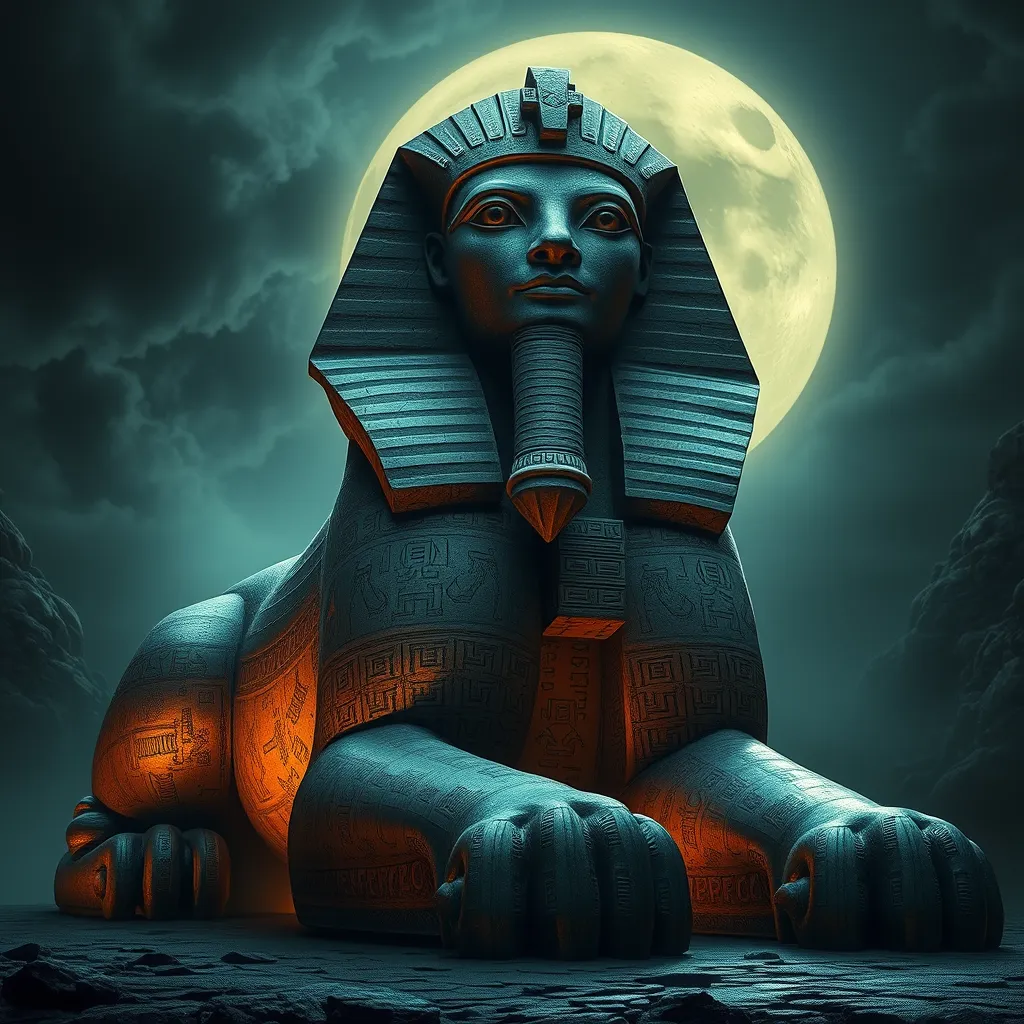The Roman Sphinx: A Guardian of the Underworld
I. Introduction
The Sphinx, a creature with a lion’s body and a human head, holds a significant place in various ancient cultures, particularly within Roman society. In Roman culture, the Sphinx embodies duality, wisdom, and the mysteries of existence, serving as a bridge between the human and the divine. Its role as a guardian of the underworld reinforces its importance in the spiritual and cultural landscape of ancient Rome.
The Sphinx’s portrayal as a sentinel at the gates of the afterlife highlights its significance in guarding the passage to the underworld, ensuring that only the worthy may enter. This article explores the historical context, symbolism, architectural relevance, artistic representations, religious significance, and its comparisons with other cultural figures.
II. Historical Context of the Sphinx
A. Origins of the Sphinx in ancient mythology
The Sphinx originated in ancient Egyptian mythology, where it was often depicted as a symbol of strength and wisdom. Egyptian Sphinxes typically featured a lion’s body and a pharaoh’s head, symbolizing the protection of the ruler and the nation. The most famous example, the Great Sphinx of Giza, served as a guardian of the tombs and was thought to possess immense knowledge.
B. Influence of Greek mythology on Roman interpretations
The concept of the Sphinx was adopted and adapted by the Greeks, who infused their own mythological narratives into the figure. In Greek mythology, the Sphinx was known for its riddles and was associated with the tragic tale of Oedipus. When the Romans came into contact with Greek culture, they embraced the Sphinx, incorporating it into their own mythology and art, albeit with some modifications.
III. Symbolism of the Sphinx
A. Representation of duality: human and animal characteristics
The Sphinx symbolizes the duality of existence, combining human intelligence with animal instinct. This duality reflects the complexities of life, where human beings grapple with their primal urges while striving for higher understanding and wisdom. The Sphinx serves as a reminder of the balance between reason and instinct.
B. The Sphinx as a symbol of mystery and knowledge
With its enigmatic nature, the Sphinx represents the mysteries of the universe and the pursuit of knowledge. Its association with riddles and enigmas invites individuals to seek deeper truths and confront the unknown, making it a potent symbol of intellectual curiosity and philosophical inquiry.
IV. Architectural Significance
A. Locations of Sphinx statues in ancient Rome
In ancient Rome, Sphinx statues were strategically placed in various locations, including temples, public squares, and private gardens. Some notable sites include:
- The Temple of Isis, where Sphinxes adorned the entrances.
- The Gardens of Sallust, featuring Sphinx sculptures among the lush greenery.
- Roman villas, where Sphinxes were often used to enhance the aesthetic appeal of the landscape.
B. The Sphinx in Roman architecture and its aesthetic purpose
The incorporation of Sphinxes in Roman architecture served both decorative and symbolic purposes. As guardians, they were believed to protect sacred spaces and convey messages of power and wisdom. Their imposing presence contributed to the grandeur of structures, merging functionality with artistic expression.
V. The Sphinx in Art and Literature
A. Depictions of the Sphinx in Roman art
Roman artists frequently depicted the Sphinx in various forms, including sculptures, mosaics, and frescoes. These representations often emphasized the creature’s majestic form and enigmatic expression, capturing the imagination of viewers. The Sphinx became a popular motif in Roman decorative arts, symbolizing strength and protection.
B. References to the Sphinx in Roman literature and poetry
The Sphinx also appears in Roman literature and poetry, often symbolizing wisdom and the quest for knowledge. Poets like Ovid and Seneca referenced the Sphinx in their works, using it as a metaphor for the challenges of understanding life and the human condition. These literary references further solidified the Sphinx’s place in Roman culture.
VI. The Role of the Sphinx in Roman Religion
A. The Sphinx as a protector of the dead
In Roman religion, the Sphinx was viewed as a protector of the dead, ensuring safe passage to the afterlife. Its presence in funerary art and architecture signified the belief in the Sphinx’s role as a guardian, guiding souls through the transition from life to death.
B. Rituals and beliefs associated with the Sphinx in funerary practices
Various rituals were associated with the Sphinx in Roman funerary practices. Offerings and prayers were often directed toward the Sphinx to seek its protection for the deceased. The presence of Sphinx imagery in tombs served as a reminder of the journey beyond death, reinforcing the connection between the living and the spiritual realm.
VII. Comparisons with Other Cultures
A. The Sphinx in Egyptian mythology
In Egyptian mythology, the Sphinx was a powerful symbol of royal authority and protection. Unlike the Roman Sphinx, which often took on a more philosophical role, the Egyptian Sphinx was primarily a guardian of tombs and a representation of the pharaoh’s power. The Great Sphinx of Giza stands as a monumental representation of this cultural significance.
B. Similar guardian figures in other ancient civilizations
Many ancient civilizations featured guardian figures similar to the Sphinx. For instance:
- The **Lamassu** of Assyrian culture, a hybrid creature combining human and animal features, served as protectors of cities and palaces.
- The **Chimera** in Greek mythology, a fire-breathing monster that combined elements of various animals, represented chaos and the unknown.
- The **Manticore**, a creature from Persian mythology with a human head, lion’s body, and scorpion’s tail, symbolized danger and the supernatural.
These figures, like the Sphinx, illustrate the universal themes of protection, wisdom, and the mysteries of existence across different cultures.
VIII. Conclusion
The Sphinx holds a significant place in Roman culture as a guardian of the underworld, embodying the duality of existence and the quest for knowledge. Its historical roots, rich symbolism, architectural relevance, and representation in art and literature showcase its importance in ancient Rome. As a protector of the dead, the Sphinx reinforced the beliefs and rituals surrounding death and the afterlife.
Ultimately, the Sphinx’s legacy transcends time and culture, continuing to inspire awe and curiosity. Its enigmatic presence serves as a reminder of the mysteries that lie beyond our understanding, cementing its role as a timeless guardian of the unknown.




